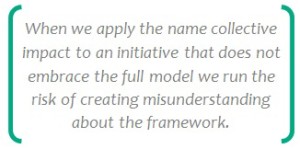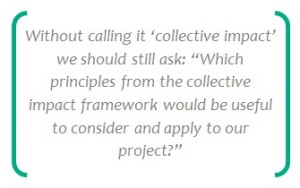Discussions about collective impact are now a regular occurrence during meetings that include social innovators or members of nonprofits. It makes sense. Not only is it the new hot topic but it also offers the promise of addressing many of the issues that these professionals have faced throughout their careers. As practitioners, it is important that we continue these discussions, building awareness of the potential of collective impact, and assuring that the developing approach is capable of delivering on its promise. It is equally important that we not overuse the term, or apply it across a wide and disparate set of programs or activities.
When we apply the name collective impact to an initiative that does not embrace the full model we run the risk of creating misunderstanding about the framework. For example, we might begin to understand collective impact to be any initiative that involves two or more separate organizations working together on a project. We could then respond to the
suggestion to use the collective impact model by getting organizations together to work on a project, creating a shared plan but skipping the discipline of developing a shared measurement system and structuring the learning dialogues and actions in response to the collective review of shared data.During a panel discussion at a recent meeting, someone brought up the idea of collective impact. A panelist responded, “I consider this conversation a collective impact conversation.” I was surprised at my reaction to his statement. I wanted to jump up and say, “No! It’s not a collective impact conversation! It’s a great conversation. But it’s not collective impact!” As I have explored the reasons behind my reaction, I have a better understanding of the benefits of being intentional with how we use the term collective impact.
When a term gets overused and spread far  beyond the original framework we set ourselves up to miss the opportunity to apply the full disciplined approach and thus not reach the broad change that collective impact is designed to achieve.
beyond the original framework we set ourselves up to miss the opportunity to apply the full disciplined approach and thus not reach the broad change that collective impact is designed to achieve.
Here are some guiding questions to consider whether an initiative calls for a collective impact approach:
• Is this an initiative that addresses a complex issue requiring us to be open to evolving solutions rather than a prescribed solution?
• Do we have the capacity in both knowledge and resources to incorporate all five conditions of the framework?
• Does this effort include a cross-sector group of stakeholders rather than a collection of only nonprofits?
Which principles from the collective impact framework would be useful to consider and apply to our project? If we answer no to any of these questions, then we are most likely not talking about a collective impact initiative. However, the effort might still benefit from the collective impact framework. Without calling it “collective impact” we should still ask:
• Which principles from the collective impact framework would be useful to consider and apply to our project?
The next series of blogs will take a look at each of the five conditions of the collective impact framework, consider the role it plays in a collective impact initiative, and then suggest what it has to offer any collective action whether it’s called a coalition, collaboration or partnership. This exploration will help us maintain the integrity of the collective impact framework, and use it to improve our collaborative work.

